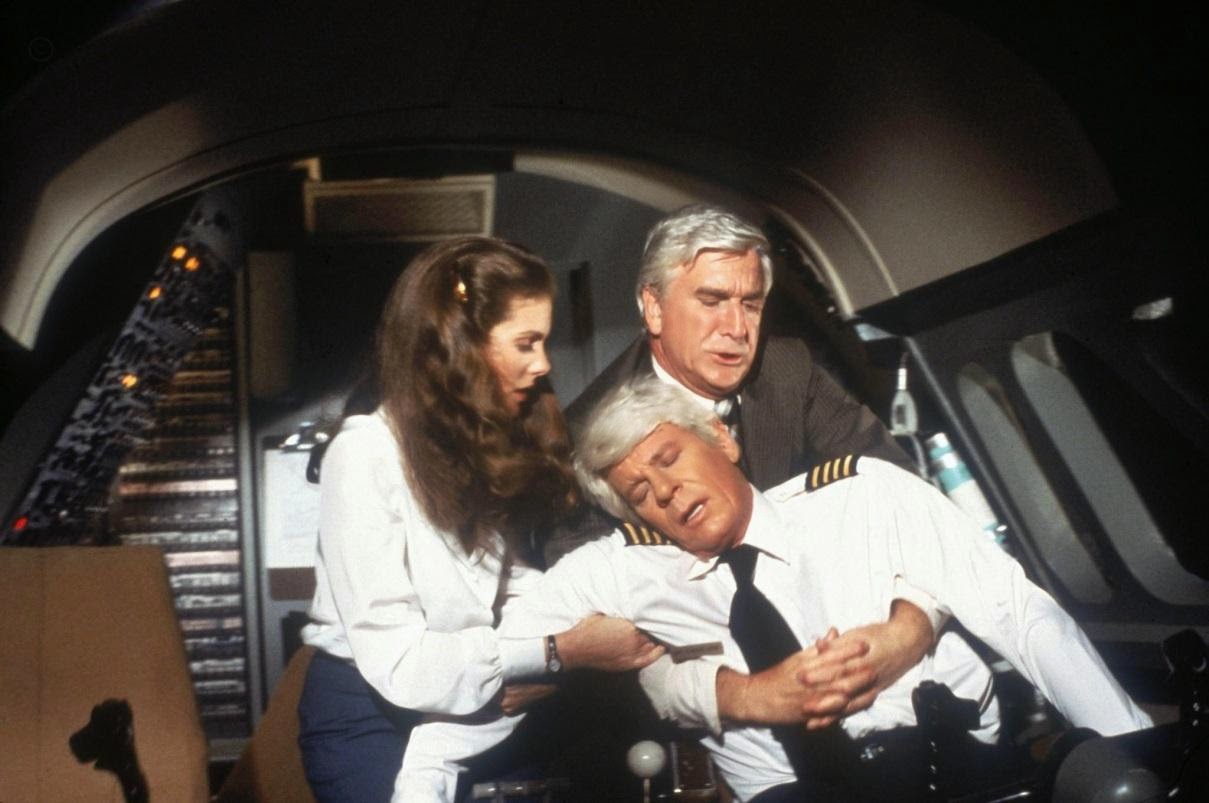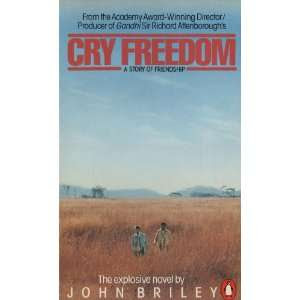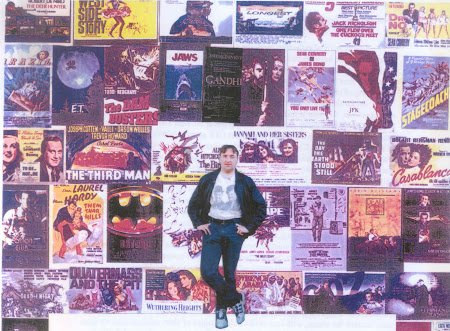Improbable they may have been, but they successfully kept me away from flying for several years (as much as audiences were also dissuaded from swimming after Jaws.) The market had been well and truly laid bare with Airport 1979: The Concorde - following on from Airport 1975 and Airport '77, going all the way back to Airport in 1969, meaning that the series had spanned practically the entire decade.
Just one year after the last Airport film, at the beginning of the 80s came its spoof, and the mother of all spoofs.
__________________
There didn't seem to be a huge difference from this....
....to this.
__________________
Such a genre was ripe for parody, but when it came, the source material was interestingly not from the 70s, but the similarly insecure 1950s.
It is probably extremely difficult not to see Zero Hour nowadays without laughing at the many unintentionally funny scenes which Airplane! was to directly parody - some of the lines are even exact reproductions!
Back in their early Kentucky Fried Theatre days (of which the anarchic comedy Kentucky Fried Movie was an early film effort), the brothers Zucker and Jim Abrahams videotaped a movie one evening in order to study the commercials that were useful material for parody (such as the Yuban "Jim never has a second cup" coffee ads), but their eyes were drawn irresistibly to the film that emerged between them: Zero Hour. Starring Dana Andrews as a traumatised WWII fighter pilot who suddenly has to re-utilise those skills when the entire crew of an airliner contract food poisoning, the film had limitless melodramatic and comedic possibilities, but played straight. It was so redolent of the 1950s, that the actual sounds of the aeroplane in Airplane! are not jets, but propellers.
The idea of a parody of Zero Hour was seized upon by Paramount, and veteran producer Howard Koch helped guide these manic undergraduate filmmakers on their airborne laughter ride of a lifetime. Many of the jokes were crude, some topical ("I haven't felt as bad as this since we watched that Ronald Reagan film"), but the bottom line was that all were funny. Depending on your taste.
With a major Hollywood studio and producer to guide it, the project therefore attracted all manner of established veterans who were happily willing to send-up their image, even if few of them they were ever qualified for comedy. Some seasoned veterans were surprisingly adept, and all gave fine deadpan comic performances: Robert Stack, Peter Graves (my personal favourite), Lloyd Bridges - and Leslie Nielsen. In the latter's case, something of a future career was forged on this kind of comedy; no longer the straight-laced hero or the earnest pragmatist for Mr. Nielsen anymore (such as the captain of the Poseidon), oh no.
As a spoof, Airplane! cast its shadow for many years, so that come 1988, its memory was still fresh in people's minds, as much surely as Nielsen's deadpan doctor. And don't call him Shirley.
Immediately after the success of Airplane! (whilst an imitative follow-up Airplane II: The Sequel was being made by other hands), the Zuckers spread their wings onto television itself, spoofing that even more ubiquitous entity on TV, the cop show. Police Squad! received a small but nonetheless devoted cult following, only lasting one series, but left possibilities in later years for further development on the big screen....
For my 18th birthday, I decided to treat my parents to dinner, rather than them treating me, as I had officially come of age; in return for that, about a month later they offered to take me out to dinner somewhere some weeks later. The film we went to see that evening: The Naked Gun.
The cinema was the Century in Clacton (already covered with some nostalgia elsewhere in this blog), in the big screen with some of the Clacton denizens. My most vivid memory of that evening at the pictures was that of my mother exploding into laughter at the sight of the Ayatollah Khomeini of Iran being kicked in the groin and punched by Lt. Frank Drebin (Nielsen), to reveal a mohican punk hairstyle under his turban! (The Zuckers often had this "explosive" effect their audiences.)
This rather sinister prologue to The Naked Gun seems oddly prescient, in view of subsequent political events where we (ie. America) went to war or near-war with most of these nasties, the two missing from the picture at the time being Saddam Hussain and Osama Bin Laden. Chief baddie of the piece however, is Vincent Ludwig (pronounced "Ludd-wigg"), played by the ever panther-like Ricardo Montalban, who could play scary villains in his sleep, and as the poster publicity so aptly puts it, "even Mother Theresa wanted him dead".
The plot is just a little more involving and dramatic than the average episode of Police Squad!, and also even scores one or two points up from Airplane! by having Frank Drebin as the central protagonist of the story rather than having several character viewpoints.
That, coupled with some hilarious set pieces. The terrorism prologue I've already mentioned, but there are plenty of others such as the hilarious opening credit sequence, Drebin's hand caught in a fish tank, and the climactic baseball game (complete with Jeanette Charles herself as the Queen) where the tone-deaf Drebin unwisely stands in for a famous opera singer and is required to sing Star Spangled Banner. My favourite is the farcical car chase with a Learner Driver (such a real possibility in the car-obsessed United States), and her bewildered instructor beautifully underplayed by the late John Houseman in a priceless uncredited cameo.
 The teaming of Nielsen and his sultry but inwardly kooky leading lady Priscilla Presley was sufficient to see through two successful sequels, The Naked Gun 2 and a Half: The Smell of Fear and The Naked Gun 33 and a Third (a title for older audiences to recognise), the last in the series featuring two figures who sadly became almost as infamous as the Zuckers and co.: O.J.Simpson, and his murdered wife Nicole Brown Simpson.
The teaming of Nielsen and his sultry but inwardly kooky leading lady Priscilla Presley was sufficient to see through two successful sequels, The Naked Gun 2 and a Half: The Smell of Fear and The Naked Gun 33 and a Third (a title for older audiences to recognise), the last in the series featuring two figures who sadly became almost as infamous as the Zuckers and co.: O.J.Simpson, and his murdered wife Nicole Brown Simpson.Neither Airplane! or The Naked Gun are masterpieces, but if films were scored on how much they made (and still make) audiences laugh, they would win the Gold and Silver at the Comedy Olympics every time.




.jpg)


+Midsummer+Night's+Dream.jpg)
.jpg)


.jpg)



















